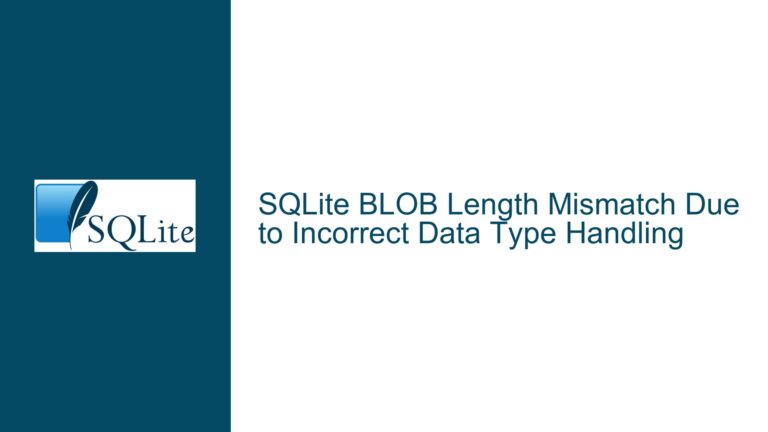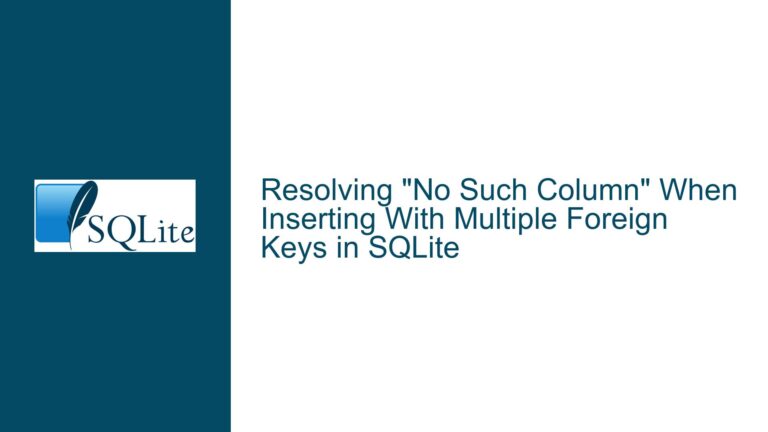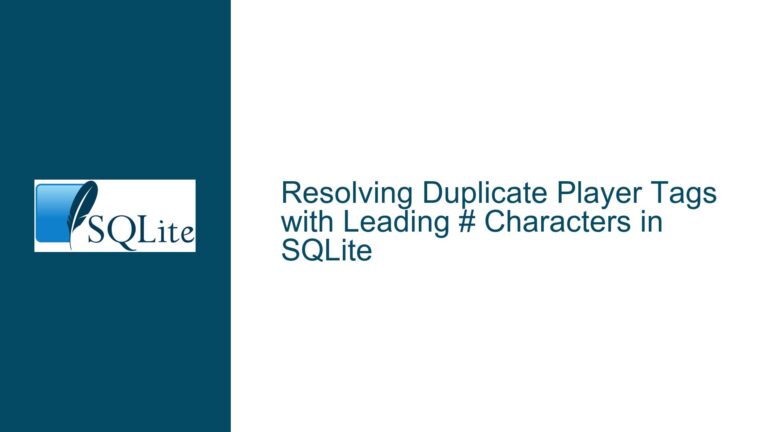Resolving Duplicate Genre Entries by Updating to Longest Genre per Directory Path in SQLite
Identifying and Updating Redundant Genre Entries with Window Functions
Core Challenge: Consolidating Multiple Genre Values per Directory Path
The fundamental task involves processing a music library table (alib) containing directory paths (__dirpath) and genre strings. Each directory path may have multiple genre entries, and the goal is to retain only the longest genre string per directory path while updating all shorter entries to match this longest value. This requires:
- Accurate identification of directory paths with multiple genre entries
- Determination of longest genre string within each directory group
- Batch update operation modifying non-longest genre entries
- Handling edge cases including tied lengths and data consistency
The complexity stems from SQLite’s specific implementation of window functions and UPDATE-FROM syntax, combined with the need to handle potential data anomalies. A production-grade solution must account for execution efficiency, data integrity, and edge case handling while working within SQLite’s functional constraints.
Critical Failure Points in Genre Consolidation Workflows
Incomplete Group Processing:
Failure to account for all directory paths with multiple genre entries results in partial data cleanup. The original CTE approach usingHAVING count(*) > 1correctly filters groups but must be maintained through subsequent processing stages.Window Function Misconfiguration:
Incorrect window frame specification (RANGEvsROWS) or improper ordering inrow_number()leads to incorrect ranking of genre lengths. The difference betweenRANGE BETWEEN UNBOUNDED PRECEDING AND UNBOUNDED FOLLOWINGand default framing becomes crucial when handling ties.Update Collision Scenarios:
Simultaneous updates to multiple rows sharing directory paths without proper isolation may cause race conditions in concurrent environments, though SQLite’s write locking mitigates this at the DBMS level.Character Encoding Miscalculations:
Incorrect length calculations due to hidden Unicode characters or improper string storage (BLOB vs TEXT) create false positives in genre length comparisons. The sample data uses BLOB for__dirpathbut TEXT forgenre, requiring explicit encoding handling.Backslash Escaping Artifacts:
Improper handling of escaped backslashes in genre strings (e.g.,Pop/Rock\\PunkvsPop/Rock\Punk) alters length calculations and comparison logic. SQLite’s string literals require double backslashes for storage as single backslashes, but this must be consistent across insertions and queries.Indexing Deficiencies:
Absence of appropriate indexes on__dirpathandLENGTH(genre)forces full table scans during window function execution and update operations, leading to quadratic time complexity on large datasets.
Comprehensive Resolution Strategy for Genre Standardization
Phase 1: Schema Validation and Index Optimization
Before executing update operations, validate table structure and implement performance optimizations:
-- Verify table schema matches expected structure
PRAGMA table_info(alib);
-- Create covering index for window function and updates
CREATE INDEX idx_alib_dirpath_genre ON alib(__dirpath, LENGTH(genre) DESC, genre);
This composite index accelerates both the PARTITION BY clause in the window function and the subsequent UPDATE join operation. The inclusion of LENGTH(genre) DESC allows SQLite to leverage index ordering for ranking calculations.
Phase 2: Precise Longest Genre Identification
Enhance the window function to handle tie scenarios and validate length calculations:
WITH ranked_genres AS (
SELECT
__dirpath,
genre,
LENGTH(genre) AS genre_len,
ROW_NUMBER() OVER (
PARTITION BY __dirpath
ORDER BY LENGTH(genre) DESC, genre DESC
) AS rank_asc,
DENSE_RANK() OVER (
PARTITION BY __dirpath
ORDER BY LENGTH(genre) DESC
) AS length_rank
FROM alib
)
SELECT
__dirpath,
genre,
genre_len,
CASE WHEN length_rank = 1 THEN 'Longest' ELSE 'Shorter' END AS category
FROM ranked_genres
WHERE __dirpath IN (
SELECT __dirpath
FROM alib
GROUP BY __dirpath
HAVING COUNT(DISTINCT genre) > 1
);
Key enhancements:
- Added
DENSE_RANK()to detect length ties - Secondary ordering on
genre DESCbreaks ties deterministically - Explicit length calculation column for verification
- Subquery filtering retains only directory paths with multiple distinct genres
Phase 3: Safe Update Execution with Collision Avoidance
Implement an idempotent update operation that only modifies necessary records:
WITH longest_genre AS (
SELECT
__dirpath,
genre,
LENGTH(genre) AS genre_len
FROM (
SELECT
__dirpath,
genre,
ROW_NUMBER() OVER (
PARTITION BY __dirpath
ORDER BY LENGTH(genre) DESC, genre DESC
) AS rn
FROM alib
WHERE __dirpath IN (
SELECT __dirpath
FROM alib
GROUP BY __dirpath
HAVING MAX(LENGTH(genre)) > MIN(LENGTH(genre))
)
)
WHERE rn = 1
)
UPDATE alib
SET genre = (
SELECT lg.genre
FROM longest_genre lg
WHERE lg.__dirpath = alib.__dirpath
)
WHERE EXISTS (
SELECT 1
FROM longest_genre lg
WHERE lg.__dirpath = alib.__dirpath
AND alib.genre != lg.genre
);
Critical safeguards:
- Correlated subquery limits updates to rows with different genre values
- EXISTS clause prevents updating directories without multiple genres
- Internal WHERE filter on directory paths ensures only conflicted groups process
- Tiebreaker via
genre DESCensures deterministic selection
Phase 4: Post-Update Validation
Execute analytical queries to confirm data integrity:
-- Verify no remaining conflicted directories
SELECT __dirpath
FROM alib
GROUP BY __dirpath
HAVING COUNT(DISTINCT genre) > 1;
-- Compare pre/post update values
WITH history AS (
SELECT __dirpath, genre AS old_genre
FROM alib_bak -- Assuming backup created pre-update
UNION ALL
SELECT __dirpath, genre AS new_genre
FROM alib
)
SELECT
__dirpath,
GROUP_CONCAT(old_genre) AS pre_update,
GROUP_CONCAT(new_genre) AS post_update
FROM history
GROUP BY __dirpath
HAVING pre_update != post_update;
Phase 5: Performance Tuning and Monitoring
For large datasets (>1M records), implement batch processing with transaction control:
BEGIN TRANSACTION;
-- Process in 10,000 directory chunks
WITH dir_batch AS (
SELECT __dirpath
FROM alib
GROUP BY __dirpath
HAVING COUNT(DISTINCT genre) > 1
LIMIT 10000
)
UPDATE alib
SET genre = (
SELECT lg.genre
FROM longest_genre lg
WHERE lg.__dirpath = alib.__dirpath
)
WHERE EXISTS (
SELECT 1
FROM dir_batch db
WHERE db.__dirpath = alib.__dirpath
AND alib.genre != (
SELECT lg.genre
FROM longest_genre lg
WHERE lg.__dirpath = alib.__dirpath
)
);
COMMIT;
This approach:
- Limits transaction size for rollback safety
- Uses batched directory processing
- Maintains ACID compliance
- Allows progress monitoring between batches
Final Implementation Considerations:
- Data Type Validation: Ensure consistent BLOB encoding for
__dirpathacross all operations to prevent comparison failures - Collation Sequences: Explicitly specify
TEXTcollation for genre comparisons if using locale-specific sorting rules - Vacuum Optimization: Post-update VACUUM operation reclaims space from updated records
- Trigger Prevention: Temporarily disable triggers during bulk update operations
- WAL Mode: Enable Write-Ahead Logging for concurrent read access during updates
By systematically addressing each failure vector through schema optimization, query refinement, and operational safeguards, this solution provides a robust framework for maintaining genre consistency in SQLite music libraries while ensuring optimal performance and data integrity.






